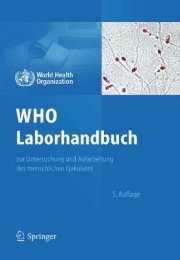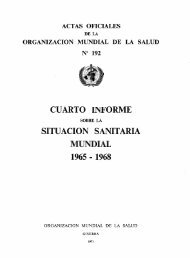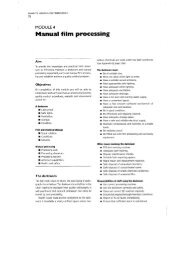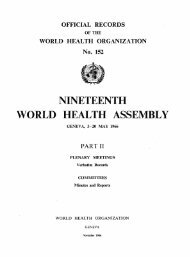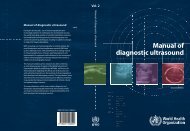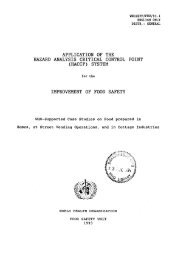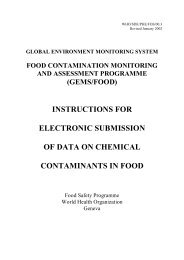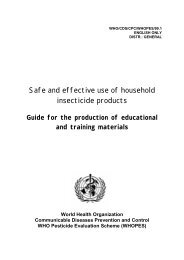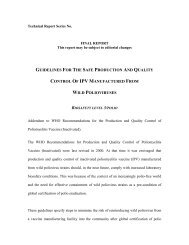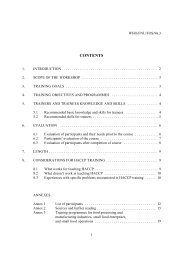CX/FAC 99/21 - World Health Organization
CX/FAC 99/21 - World Health Organization
CX/FAC 99/21 - World Health Organization
Create successful ePaper yourself
Turn your PDF publications into a flip-book with our unique Google optimized e-Paper software.
4<br />
consequence of their diet and lifespan. On the other hand, mean levels well below 0.5 mg/kg are<br />
reported from several countries (SCOOP, 1<strong>99</strong>6). Most consumers world-wide eat horsemeat only<br />
rarely and in limited quantities, but there are consumers who eat horse-meat products in quantities<br />
comparable to other meat types. There have been problems recorded in the trade of horse-meat<br />
because of the cadmium content.<br />
17. The content of cadmium in liver and especially kidney, is substantially higher than in the<br />
animal muscle. In liver of calf, pig and poultry, which is most frequently consumed, the levels<br />
normally found range from 0.02 to 0.2 mg/kg. Higher levels of cadmium may again be found in liver<br />
from older animals.<br />
As cadmium accumulates in the animal kidney bound to metallothioneines, this organ may contain<br />
rather high levels of cadmium. The cadmium levels generally found in kidney from calf and pig<br />
normally range from 0.05 to 0.5 mg/kg, whereas the content in bovine kidney may approach 1<br />
mg/kg. Kidney and liver from horse (if at all considered a food) may exceed 10 mg/kg, and should be<br />
avoided, or only eaten rarely.<br />
18. Fish will normally not be a major source to cadmium. The contents reported are generally<br />
low, in the parts per billion range. Contents reported are most frequently in the order of 0.02 mg/kg,<br />
though higher levels are occasionally found in some species or in fish from contaminated waters and<br />
sediments (SCOOP 1<strong>99</strong>6; ref. 9).<br />
19. Crustaceans, especially crabs, and some bivalve molluscs may contain substantial amounts of<br />
cadmium. The "brown meat" of the crab which is normally removed before consumption may<br />
accumulate more than 10 mg/kg cadmium (MAFF, 1983). Bivalve molluscs will normally contain<br />
perhaps 0.2 mg/kg cadmium, but as the molluscs may accumulate cadmium from contaminated<br />
waters by filtration, the contents found are sometimes considerably higher.<br />
20. In other foods, unless incidentally contaminated, the average cadmium content will be<br />
negligible and will not contribute significantly to the intake.<br />
<strong>21</strong>. The content of cadmium in food, as reflected in intake estimates, appears to decrease only<br />
slowly or to remain constant within the uncertainty of surveys from recent years (Council of Europe<br />
1<strong>99</strong>5; Danish VFA 1<strong>99</strong>5 and 1<strong>99</strong>9). Source-directed measures like those recommended in the<br />
"Position Paper on Cadmium" (<strong>CX</strong>/<strong>FAC</strong> 95/19) and the Draft Code of Practice for Source-related<br />
Measures (<strong>CX</strong>/<strong>FAC</strong> 96/20 and <strong>CX</strong>/<strong>FAC</strong> 98/20) will certainly have an impact on lowering the<br />
environmental burden. However, these measures still await full implementation.<br />
INTAKE CONSIDERATIONS<br />
22. The dietary intake of cadmium for many countries world-wide is presented by surveys from<br />
UNEP (UNEP/FAO/WHO, 1<strong>99</strong>2) and also by the SCF (SCOOP, 1<strong>99</strong>6) and others, see table 2. The<br />
methods of estimation used are different and they are reported in the original papers. The average<br />
intake is approximately 10 to 50 μg/day in areas of normal exposure, but may be higher in certain<br />
countries (ICPS EHC 134, 1<strong>99</strong>2). These figures, providing documentation for the statement<br />
concerning the small safety margin between exposure from the normal diet and exposure that<br />
produces deleterious effects, confirm the reason for taking action to reduce the exposure to cadmium<br />
from the diet, both for the average consumer and even more so for those who are particularly<br />
exposed because of local contamination, particular dietary habits or because they are additionally<br />
exposed as tobacco smokers or occupationally.<br />
23. JECFA in 1<strong>99</strong>3 expressed concern about having to use retrospective data for estimating the



